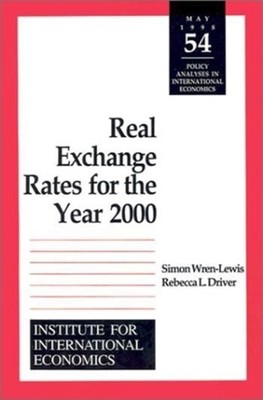
- We will send in 10–14 business days.
- Author: Simon Wren-Lewis
- Publisher: Peterson Institute for International Economics
- ISBN-10: 0881322539
- ISBN-13: 9780881322538
- Format: 15.4 x 22.9 x 1.3 cm, minkšti viršeliai
- Language: English
- SAVE -10% with code: EXTRA
Reviews
Description
Countries that enter the European Monetary Union must do so at exchange rates that are close to equilibrium levels. So when are exchange rates at equilibrium levels? Real Exchange Rates for the Year 2000 discusses the fundamental equilibrium exchange rate (FEER) method of estimating an equilibrium real exchange rate, and it estimates FEERs for the G7 countries for 1995 and 2000. There have been large swings in all G7 currencies in the last five years, and in these circumstances, the markets and policymakers need better guides to the sustainable levels of these currencies, which this report provides. The authors estimate equilibrium real exchange rates using a partial-equilibrium model based on econometric trade equations, assumptions of trend output, and estimates of the medium-run current account. They emphasize that the FEER is a medium-run construct and contrast it with the purchasing price parity (PPP) method of determining equilibrium real exchange rates. The authors discuss the links between the FEER and fiscal policy and the extent to which the FEER is a normative concept. They conclude with sensitivity analysis for changes in current account and trend GDP assumptions.
EXTRA 10 % discount with code: EXTRA
The promotion ends in 22d.21:15:33
The discount code is valid when purchasing from 10 €. Discounts do not stack.
- Author: Simon Wren-Lewis
- Publisher: Peterson Institute for International Economics
- ISBN-10: 0881322539
- ISBN-13: 9780881322538
- Format: 15.4 x 22.9 x 1.3 cm, minkšti viršeliai
- Language: English English
Countries that enter the European Monetary Union must do so at exchange rates that are close to equilibrium levels. So when are exchange rates at equilibrium levels? Real Exchange Rates for the Year 2000 discusses the fundamental equilibrium exchange rate (FEER) method of estimating an equilibrium real exchange rate, and it estimates FEERs for the G7 countries for 1995 and 2000. There have been large swings in all G7 currencies in the last five years, and in these circumstances, the markets and policymakers need better guides to the sustainable levels of these currencies, which this report provides. The authors estimate equilibrium real exchange rates using a partial-equilibrium model based on econometric trade equations, assumptions of trend output, and estimates of the medium-run current account. They emphasize that the FEER is a medium-run construct and contrast it with the purchasing price parity (PPP) method of determining equilibrium real exchange rates. The authors discuss the links between the FEER and fiscal policy and the extent to which the FEER is a normative concept. They conclude with sensitivity analysis for changes in current account and trend GDP assumptions.


Reviews